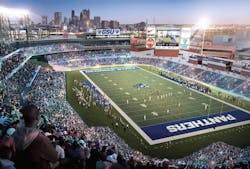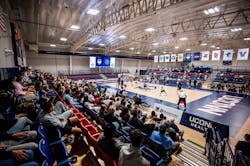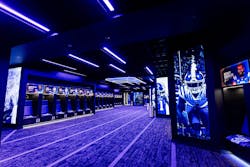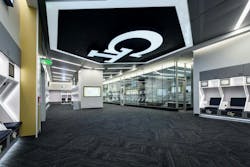5 smart design moves that drive big results in college sports
From beach volleyball locker rooms to 100,000-seat football stadiums, collegiate sports facilities are more than just places to prepare for games and compete—they play a key role in attracting and developing top athletes. Today, designers of these facilities are leveraging new technologies and innovations to create spaces that elevate team pride, enhance wellness, and improve the spectator experience. But with departments being asked to stretch their budgets farther than ever, many schools face significant hurdles when it comes to upgrading their facilities or building new ones.
Despite those challenges, strategic design moves—even modest ones—can deliver results when it comes to attendance, recruitment, and revenue. The following examples show how thoughtful, cost-conscious improvements can make a difference in college sports.
1. Unlocking value by renovating and reusing infrastructure
When the need arises for a new facility, an existing space can be just as good as building new. At Sacred Heart University in Fairfield, Conn., SLAM’s sports architecture practice reimagined an existing venue into a 2,000-seat basketball, volleyball, and wresting arena that focused on engaging fans and boosting revenue.
The new design involved rotating the court, allowing for seating on all sides and bringing fans closer to the action. Combined with new scoreboards, branding, and lighting, the project resulted in an elevated experience for all participants, and attendance has almost doubled. The $8 million construction cost provided great value for the positive impact it has provided for fans and student athletes alike.
SLAM’s nine-month renovation of a former major league baseball field into Georgia State University’s football stadium shows the impact of careful planning and analysis. Originally built for the 1996 Atlanta Olympics, and later converted to Turner Field for the Atlanta Braves, the renovated stadium gained more seats, suites, and modern amenities through the thoughtful repurposing of existing infrastructure than would have been achievable in a new football stadium—and all for a fraction of the cost of building new.
The $20 million renovation focused on the new field, sideline seats, locker rooms, sports lighting, and broadcast facilities, while preserving the history and legacy of the Olympic and MLB facility.
The project also kicked off a revitalization and redevelopment of the surrounding 70 acres of former parking lots into true year-round amenities for the surrounding Summerhill neighborhood. The stadium renovation has shifted the epicenter of GSU Athletics to this part of campus with a new convocation center, future baseball stadium, and athletics administration within immediate proximity.
2. Repurposing with purpose
As collegiate sports and rosters continue to fluctuate, creatively transforming locker rooms from one sport to another is a way to provide athletes spaces that set them up to achieve greater success. When the University of Texas needed a locker room for its newly added beach volleyball team, SLAM designed one in the space that formerly housed the university’s cheer team.
The old locker room, which was dated with exposed concrete block walls, was transformed into a bright, modern space with new lockers, a lounge, and a kitchenette.
At the University of Georgia, SLAM retrofitted a vacant football locker room to one for men’s and women’s track and field for under $6 million. The remade facility features a modern lobby, convenient mud room, player’s lounge, and spacious lockers. A salon-inspired lounge offers the female competitors a place to convene while preparing their hair, makeup, and nails—a nod to the “look good, feel good, play good” mindset and an important team bonding activity.
The University of Connecticut also made smart use of existing assets, converting an old hockey arena into an indoor volleyball venue. By transforming the existing volume and stretching their dollars, the university provided space with everything the team needed: a competition court, practice space, and locker rooms. The $3.5 million project provided a 1,100-seat venue, positioning the program for continued growth.
3. Incorporating technological innovations
Technology can elevate everyday spaces into next-level recruitment tools. At the Georgia Institute of Technology, SLAM completed a significant football locker room upgrade for less than $5 million. The project included an array of high-tech features, including in-locker ventilation systems, phone charging stations, and digital screens at each locker.
On recruiting visits, the space becomes that much more impactful when a recruit sees their own name and image on what could be their new locker.
West Virginia University’s recently completed football locker room carries many of the same amenities, while trading the digital screens at every locker for a series of larger screens in the central team gathering space, along with color-changing LED lights that sync for an audio-visual experience to get the team hyped for competition.
4. Prioritizing health and wellness
Student athlete recovery and well-being are the front and center of SLAM’s collegiate sports designs. Even when a complete sports medicine or recovery renovation isn’t possible, strategic additions to locker room and lounge projects can provide great impact. For Duke Athletics, a football locker room refresh included new lockers with low-dose UV lighting systems for sterilization.
Across the space, antimicrobial lighting disinfects more than 90% of surfaces and gear, supporting the long-term success and health of the athletes and staff. Massage chairs incorporated into the lounge space offer another way to recover from strenuous workouts, underscoring how small touches can enhance performance and extend careers.
Georgia Tech’s football locker room renovation included the addition of hydrotherapy with hot and cool plunge pools right in the locker room to aid in athlete recovery after practices and competition. WVU’s new facility incorporated a mud room and cool down plunge pool adjacent to the new locker room.
Locating these pools within or next to the locker rooms assures players will conveniently be able to properly cool down and recover throughout the year.
5. Refreshing the brand
From lockers to walls and ceilings, branding makes spaces stand out. Updating and refreshing a team’s brand graphics provides an energy and emotional boost. While graphics refreshes on their own can provide this boost, when incorporated into facility design projects, the branding can be fully integrated into the design for a cohesive, new impactful space.
SLAM partnered with Jack Porter to create team spaces at Duke, Georgia Tech, UGA, and WVU (with more on the way at Tennessee, Notre Dame, and Clemson) that are centered around recruitment performance. Fresh graphics and digital signage bring the space to life and highlight the team’s culture.







